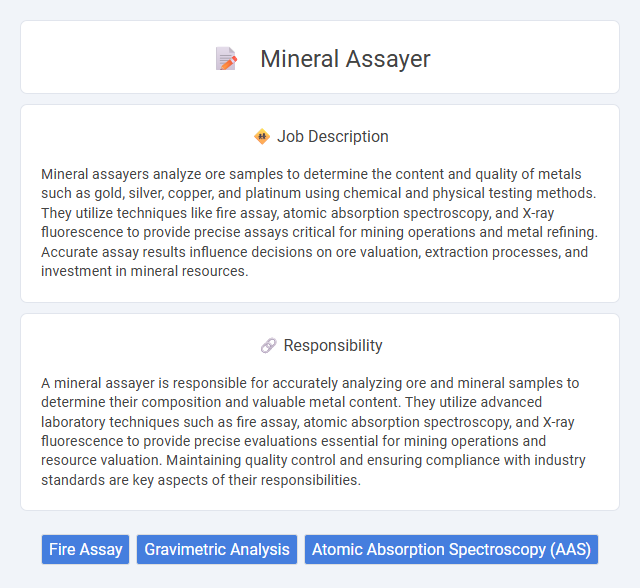
Mineral assayers analyze ore samples to determine the content and quality of metals such as gold, silver, copper, and platinum using chemical and physical testing methods. They utilize techniques like fire assay, atomic absorption spectroscopy, and X-ray fluorescence to provide precise assays critical for mining operations and metal refining. Accurate assay results influence decisions on ore valuation, extraction processes, and investment in mineral resources.
Individuals with strong analytical skills and a keen attention to detail may find a career as a mineral assayer suitable, as the job requires precise testing and evaluation of mineral samples. Those who are comfortable working in laboratory environments and can handle repetitive tasks might be well-suited for this role. However, people prone to monotony or with limited interest in scientific processes might view this job as less fitting for their preferences.
Qualification
A mineral assayer typically requires a degree or diploma in geology, chemistry, or metallurgy, with strong knowledge of analytical techniques and mineral identification. Proficiency in laboratory testing methods, such as fire assay, atomic absorption spectroscopy, and X-ray fluorescence, is essential for accurate evaluation of ore samples. Certification or relevant professional experience in mineral analysis enhances job prospects and credibility in the mining industry.
Responsibility
A mineral assayer is responsible for accurately analyzing ore and mineral samples to determine their composition and valuable metal content. They utilize advanced laboratory techniques such as fire assay, atomic absorption spectroscopy, and X-ray fluorescence to provide precise evaluations essential for mining operations and resource valuation. Maintaining quality control and ensuring compliance with industry standards are key aspects of their responsibilities.
Benefit
A mineral assayer job likely offers benefits such as valuable industry experience and skill development in analyzing ore quality. There is a strong probability of gaining hands-on knowledge in advanced testing techniques and lab equipment operation. Job opportunities might also include competitive pay and potential for career growth in mining and metallurgical sectors.
Challenge
A mineral assayer job probably involves complex challenges related to accurately analyzing the composition of ores and minerals, which requires precision and attention to detail. The role likely demands problem-solving skills to interpret test results effectively and troubleshoot inconsistencies in assays. Working under tight deadlines and maintaining high accuracy in a laboratory setting may further increase the complexity of the challenges faced.
Career Advancement
A career as a mineral assayer offers significant opportunities for advancement through gaining expertise in metallurgical testing, chemical analysis, and quality control of mineral samples. Progression often leads to senior roles such as lead assay technician, laboratory supervisor, or quality assurance manager within mining companies, refining plants, or geological survey organizations. Continuous professional development and certification in analytical techniques enhance prospects for higher salaries and leadership positions in the mineral assay industry.
Key Terms
Fire Assay
A mineral assayer specializing in fire assay performs precise quantitative analysis of precious metals such as gold, silver, and platinum in ore samples. This process involves melting samples with fluxes to separate valuable metals from impurities, providing accurate measurements critical for mining and refining industries. Mastery of fire assay techniques ensures reliable valuation and quality control of mineral resources.
Gravimetric Analysis
Mineral assayers specializing in gravimetric analysis measure the quantity of specific minerals by isolating and weighing precipitates from ore samples. This precise method involves chemical treatment to convert minerals into weighable forms, ensuring accurate determination of metal content such as gold, silver, and lead. Expertise in gravimetric techniques is essential for validating ore grades and supporting mining operations with reliable assay results.
Atomic Absorption Spectroscopy (AAS)
A Mineral Assayer specializing in Atomic Absorption Spectroscopy (AAS) performs precise quantitative analysis of metal concentrations in ore, minerals, and soil samples. Utilizing AAS technology, they detect trace elements such as lead, copper, and zinc by measuring light absorption at specific wavelengths, ensuring accurate compositional data for mining and metallurgical processes. Proficiency in sample preparation, instrument calibration, and data interpretation is essential to deliver reliable and reproducible assay results critical for resource evaluation and quality control.
 kuljobs.com
kuljobs.com